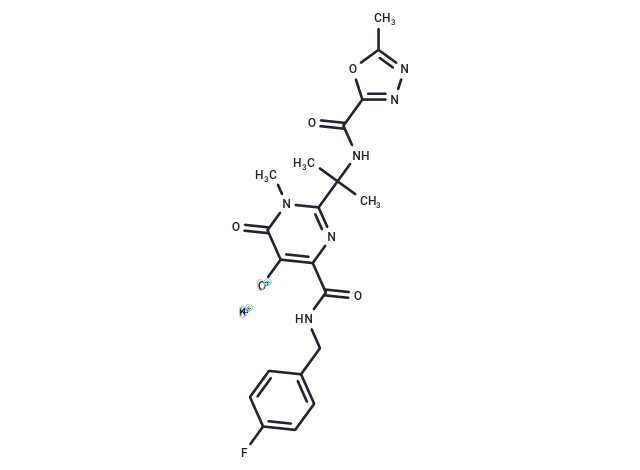Shopping Cart
- Remove All
 Your shopping cart is currently empty
Your shopping cart is currently empty

Raltegravir potassium (MK 0518 potassium salt) salt(MK0518 potassium salt) is a potent integrase (IN) inhibitor, used to treat HIV infection.

| Pack Size | Price | Availability | Quantity |
|---|---|---|---|
| 25 mg | $37 | In Stock | |
| 50 mg | $58 | In Stock | |
| 100 mg | $107 | In Stock | |
| 200 mg | $161 | In Stock | |
| 500 mg | $272 | In Stock | |
| 1 mL x 10 mM (in DMSO) | $29 | In Stock |
| Description | Raltegravir potassium (MK 0518 potassium salt) salt(MK0518 potassium salt) is a potent integrase (IN) inhibitor, used to treat HIV infection. |
| In vitro | PFV IN with the S217H substitution displays a significant reduction in susceptibility to Raltegravir, evidenced by a 10-fold increase in IC50 value to 900 nM, compared to its wild-type (WT) counterpart. Additionally, this variant retains only 10% of the WT activity and experiences a decreased responsiveness to Raltegravir, with an IC50 of 200 nM, indicating around a twofold decline in susceptibility to the integrase strand transfer inhibitor (INSTI) relative to WT IN. Conversely, the S217Q PFV IN variant mirrors the WT enzyme in sensitivity towards Raltegravir. Raltegravir undergoes metabolism predominantly through glucuronidation rather than hepatic processes and demonstrates strong in vitro efficacy against HIV-1, with a 95% inhibitory concentration of 31±20 nM in human T lymphoid cell cultures, and against HIV-2 in CEMx174 cells, with an IC95 of 6 nM. The metabolism of Raltegravir is chiefly via glucuronidation, and UGT1A1 inducers significantly decrease its concentrations, thus, such drugs should be avoided. Raltegravir slightly inhibits hepatic cytochrome P450 activity without affecting CYP3A4 RNA expression or CYP3A4-dependent testosterone 6-β-hydroxylase activity. Its cellular permeability decreases in the presence of magnesium and calcium. Raltegravir and other HIV-1 IN strand transfer inhibitors efficiently inhibit viral replication, with Raltegravir showing potent anti-SIVmac251 activity, achieving an EC90 in the low nanomolar range in infected human lymphoid CD4+ T-cell lines MT-4 and CEMx174. |
| In vivo | Raltegravir prompts viro-immunological enhancement in nonhuman primates with advancing SIVmac251 infection. A singular non-human primate demonstrated an undetectable viral load subsequent to undergoing monotherapy with Raltegravir[5]. |
| Cell Research | Human MT-4 cells are infected for 2 hours with the SIVmac251, HIV-1 (IIIB) and HIV-2 (CDC 77618) stocks at a multiplicity of infection of, approximately, 0.1. Cells are then washed three times in phosphate buffered saline, and suspended at 5 × 105/mL in fresh culture medium (to primary cells 50 units/mL of IL-2 are added) in 96-well plates, in the presence or absence of a range of triplicate raltegravir concentrations (0.0001 μM-1 μM). Untreated infected and mock-infected controls are prepared too, in order to allow comparison of the data derived from the different treatments. Viral cytopathogeniciy in MT-4 cells is quantitated by the methyl tetrazolium (MTT) method (MT-4/MTT assay) when extensive cell death in control virus-infected cell cultures is detectable microscopically as lack of capacity to re-cluster. The capability of MT-4 cells to form clusters after infection. Briefly, clusters are disrupted by pipetting; and, after 2 hours of incubation at 37°C, the formation of new clusters is assessed by light microscopy (100× magnification). Cell culture supernatants are collected for HIV-1 p24 and HIV-2/SIVmac251 p27 core antigen measurement by ELISA. In CEMx174-infected cell cultures, which show a propensity to form syncytia induced by the virus envelope glycoproteins, syncytia are counted, in blinded fashion, by light microscopy for each well at 5 days following infection. |
| Alias | Raltegravir potassium salt, MK 0518 potassium salt |
| Molecular Weight | 482.51 |
| Formula | C20H20FN6O5·K |
| Cas No. | 871038-72-1 |
| Smiles | [K+].Cc1nnc(o1)C(=O)NC(C)(C)c1nc(C(=O)NCc2ccc(F)cc2)c([O-])c(=O)n1C |
| Relative Density. | 1.46 g/cm3 |
| Storage | Powder: -20°C for 3 years | In solvent: -80°C for 1 year | Shipping with blue ice. | |||||||||||||||||||||||||||||||||||
| Solubility Information | DMSO: 87 mg/mL (180.31 mM), Sonication is recommended. | |||||||||||||||||||||||||||||||||||
Solution Preparation Table | ||||||||||||||||||||||||||||||||||||
DMSO
| ||||||||||||||||||||||||||||||||||||

Copyright © 2015-2025 TargetMol Chemicals Inc. All Rights Reserved.